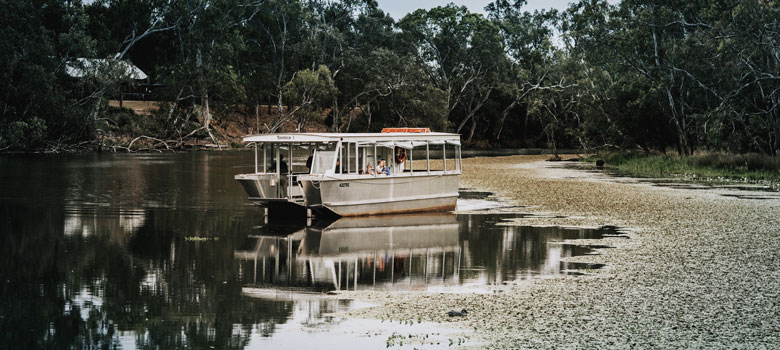
Wine
Tahbilk: An Ecosystem That Thrives
Tahbilk has a deep history of visionary, forward-thinking characters who have all played a part in the tapestry that makes this winery’s story so fascinating and endearing.
Tahbilk has always embraced innovation. As fourth generation winemaker Alister Purbrick, whose family has owned the winery for five generations, describes, “My grandfather Eric made the move from fortified wine, which dominated the Australian wine market, to table wine very early on in the 1930s. Tahbilk was amongst the first of the Australian wineries to adopt varietal-labelling, with Eric’s flagship 1948 Bin 11 Shiraz leading the charge.”
The installation of a cutting-edge, high tech winery in the late-1970s led to Tahbilk picking up many wine show awards from the 1979 vintage and today, there is a fine balance between the tradition of a wine estate of great historical significance and the tools of the modern winemaker.
Sustainable Steps
Producing the best fruit possible has always been at the core of the Tahbilk philosophy and over the years, much work has been done in the vineyard to ensure that the old adage ‘great wine begins in the vineyard’ rings true.
Tahbilk lies in a special place. The traditional owners, the Taungurung people, call it ‘Tabilk-Tabilk’ or ‘place of many water holes’ on account of its 11 kilometres of frontage to the Goulburn River and a further eight kilometres of backwaters and anabranches. It is a delicately balanced ecosystem and much work has been done to ensure this balance can be preserved and the wetlands can be enjoyed by future generations.
In 1995, the first steps were taken to protect the delicate ecosystem and over the years extensive work has been completed to rehabilitate the Tahbilk Wetlands & Wildlife reserve, including returning 160 hectares of the property to revegetation to attract increased numbers of birdlife and animals.
The Tahbilk Eco Trail, a series of nature walking paths, bird hides, timber boardwalks and docking points for the Eco Trail boats opened in 2005, allowing visitors to immerse themselves in the diverse landscape of the Goulburn River and its wetlands.
In 2008, work was extended to provide a deeper understanding of the wetlands’ Greenhouse Gas (GHG) profile and establish baselines for calculating the carbon stored onsite by revegetation activities. Further revegetation ensued, a 100KW solar system and organic waste treatment/recycling facility was added and investment in carbon reduction schemes enabled Tahbilk to achieve its goal of becoming carbon neutral in 2012.
Today, fifth-generation Hayley Purbrick is the driving force behind Tahbilk’s inspiring environmental custodianship. As she explains, “It’s all about how we can create beneficial ecosystems where we can all thrive. Thinking about how we manage landscape, understanding ecology and our ecosystems is central. It is about moving in harmony with the landscape.”
“With the local Taungurung association, we’ve been working out who was here, what was here, learning more about the local indigenous people and the part they play in our landscape.
“Our initial efforts were mainly centred around revegetation, when I came onboard I started asking questions about what else could be beneficial to us as a wine region. We are three degrees colder here than other wineries, due to our proximity to the water, trees and soil type. It’s got us thinking about how you can create your own ecosystem to manage the temperature and environment and continue to grow high quality fruit. So all of our efforts work off that premise. We don’t only grow grapes; we look after our land in such a way that it creates an environment where great grapes can grow.”
Expanding Horizons
The Tahbilk vineyard and winery continue to be audited annually and through a process of measuring emissions, reducing those emissions and offsetting residual emissions, they are accredited carboNZero with Toitu Envirocare, one of only eight wineries globally to be accredited at both a product and organisational level.
Hayley would also like to see the winery become a research hub. As she explains, “A point where we can be a working case study of the benefits of substantial native plantings surrounding the vineyards and what that means for the quality of your produce and risk mitigation, and how it impacts the climate and health of the land. Personally, I’d like to see us get to the point where we can create some sort of foundation to inspire others to do the same.
“At the end of the day, you have to have a sustainable business and produce great wines, you have to have community, you have to look after your environment and it all has to be in balance. I feel like we are on a good, ethical pathway now to achieve all those things. There is also a sense of pride regarding this for our family. Our legacy is we want to make the best wines possible and leave something behind that future generations can be proud of.”
As Tahbilk celebrates their 160th anniversary, it is safe to say that the current custodians, the Purbrick family, are ensuring that this grand and much admired family-owned estate has a very bright future indeed.